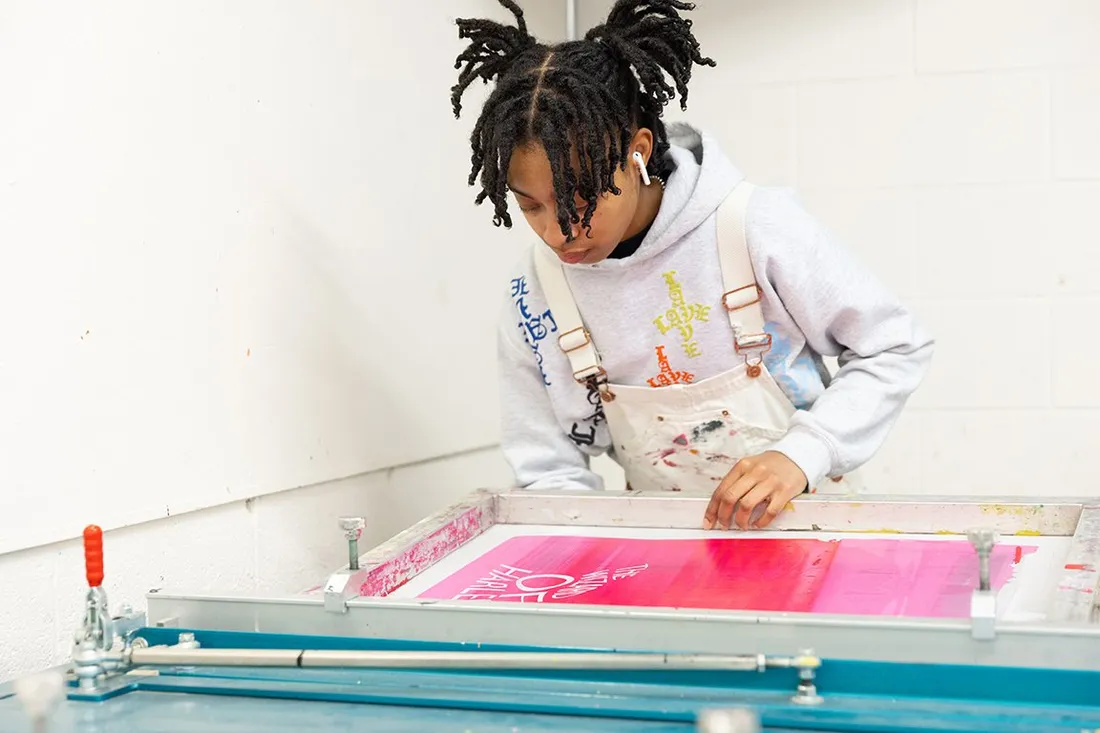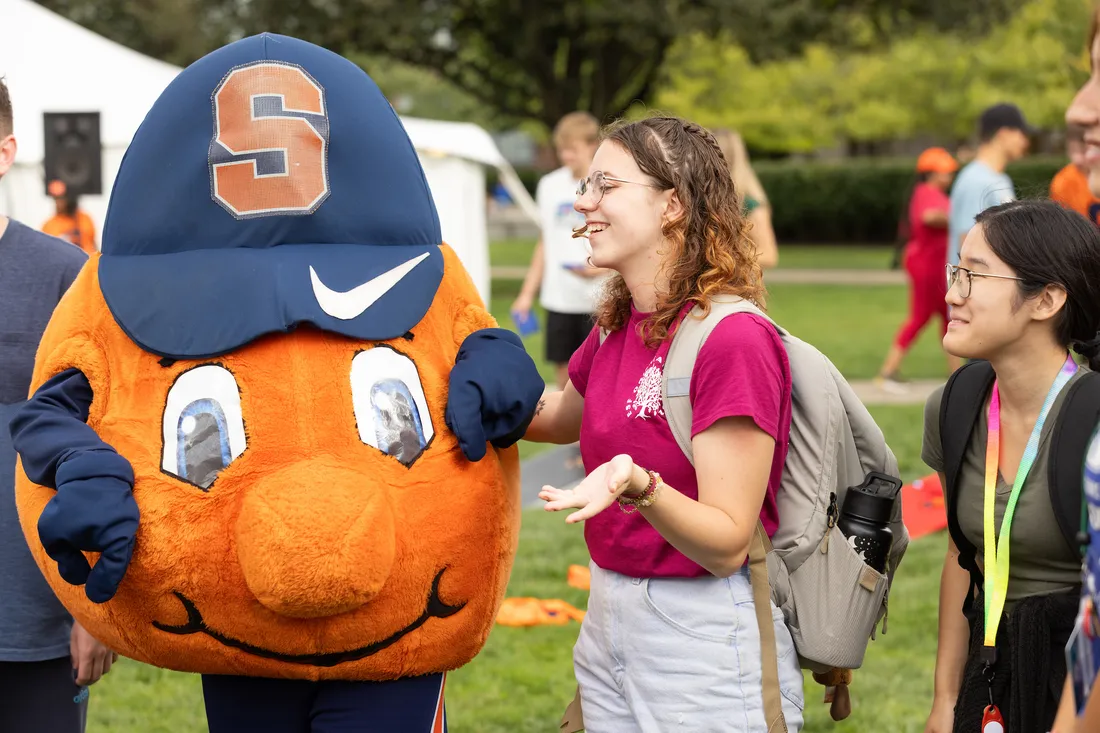Many institutions have secret societies—underground groups that practice various rituals and traditions. Syracuse University is no exception. One such society is no secret at all, hidden in plain sight in Crouse College. They are part of a gang of musicians known as Chimesmasters, who, as the name suggests, engage in the fraternal tradition of bell playing.
Three times a day, members of this elusive club scale a 70-foot ladder to the building’s cavernous belfry. “We believe the Crouse Chimes should be separate from the people who play them,” says one student, drawing a comparison to the Otto mascot team, whose participants are also anonymous. “Each bell has its own tone, its own personality. Collectively, the chime creates something bigger than all of us.”
It draws on my two passions: making music and building community.
Ross Chua ’20, G’21
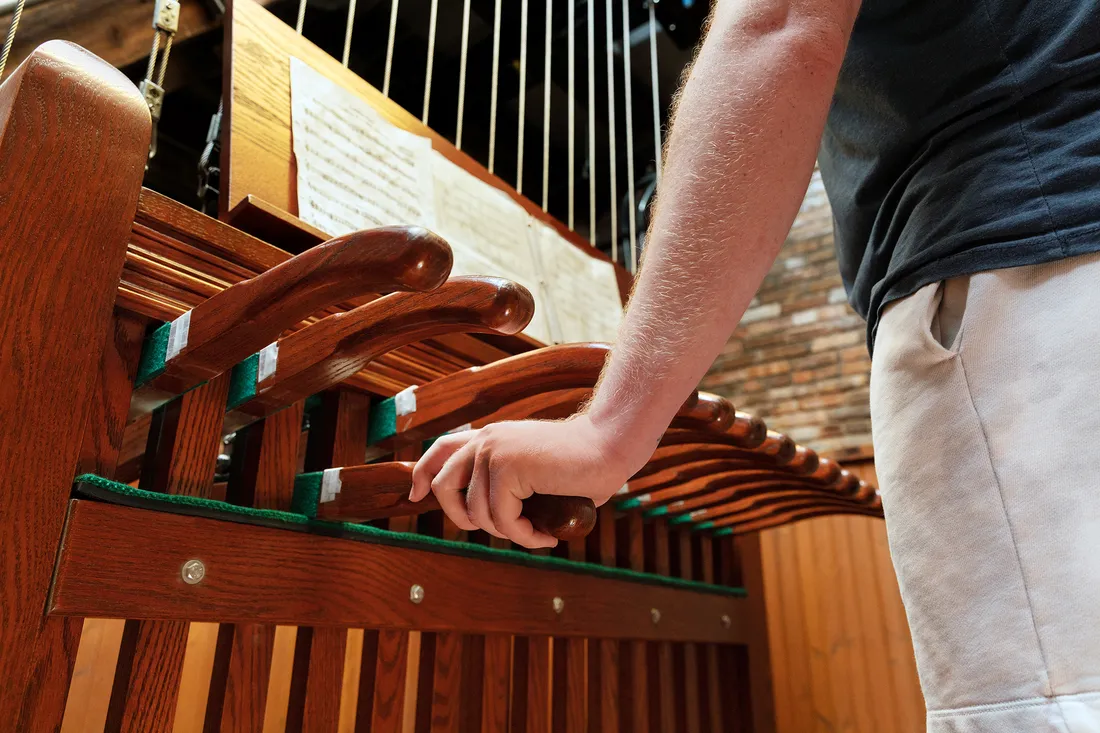
Chimesmasters carry on the University tradition of bell playing, which began more than 130 years ago.
That “something” is a powerful musical force, capable of uniting and inspiring. Operated by a system of levers and pulleys, the University’s 14 bronze-cast bells speak where words fail, to paraphrase author Hans Christian Andersen. The size and shape of each bell determine its note and sound quality, producing a palette of harmonic overtones.
Such tonal color supports a rich and varied playlist, explains faculty advisor Joseph Downing. “We try to combine the traditional with the contemporary,” he says, adding that each 15-minute concert, or shift, is bookended by “Westminster Chimes” and the alma mater, respectively. Another staple is the fight song, which echoes throughout campus on gameday.
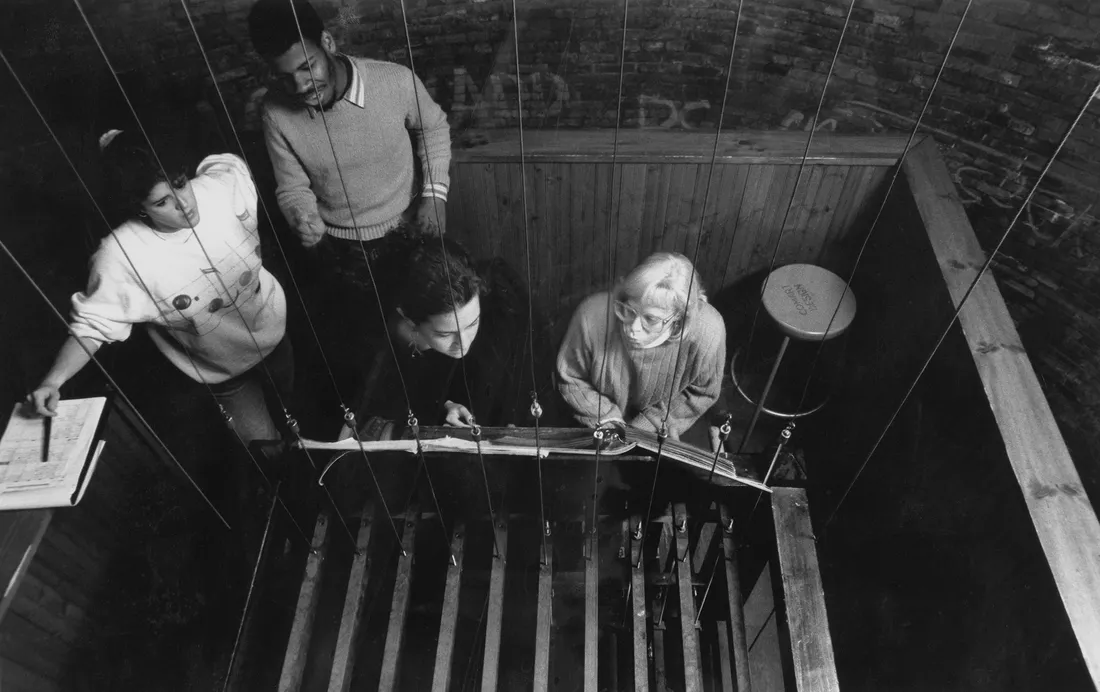
Chimesmasters own more than a thousand pieces of music, divided by genre among four large binders. (Syracuse University Archives, Special Collections Research Center)
Equally compelling is the chimes’ history. Originally cast at the now-defunct Meneely Foundry in Troy, New York, the first nine bells were installed on campus in the spring of 1889. The largest bell, the 3,000-pound “Big John,” was named for the University Trustee who erected Crouse College. John Crouse didn’t live to see his building finished, but he heard the bells make their anticipated debut on his 87th birthday.
A tenth bell was added in 1937, followed by four more in 2016. “The latest set was cast by Royal Dutch Foundries, one of only a few in the world still making bells with pitches,” adds Downing, an associate professor of music in the College of Visual and Performing Arts. “The sound of our bells is so massive that you can hear them a mile away.”
Members of Delta Kappa Epsilon rang the Crouse Chimes for nearly a century before ceding control to a coterie of students in the late 1980s. Calling themselves Chimesmasters, the new caretakers sought to operate in complete secrecy. Still do.
Making Music, Building Community
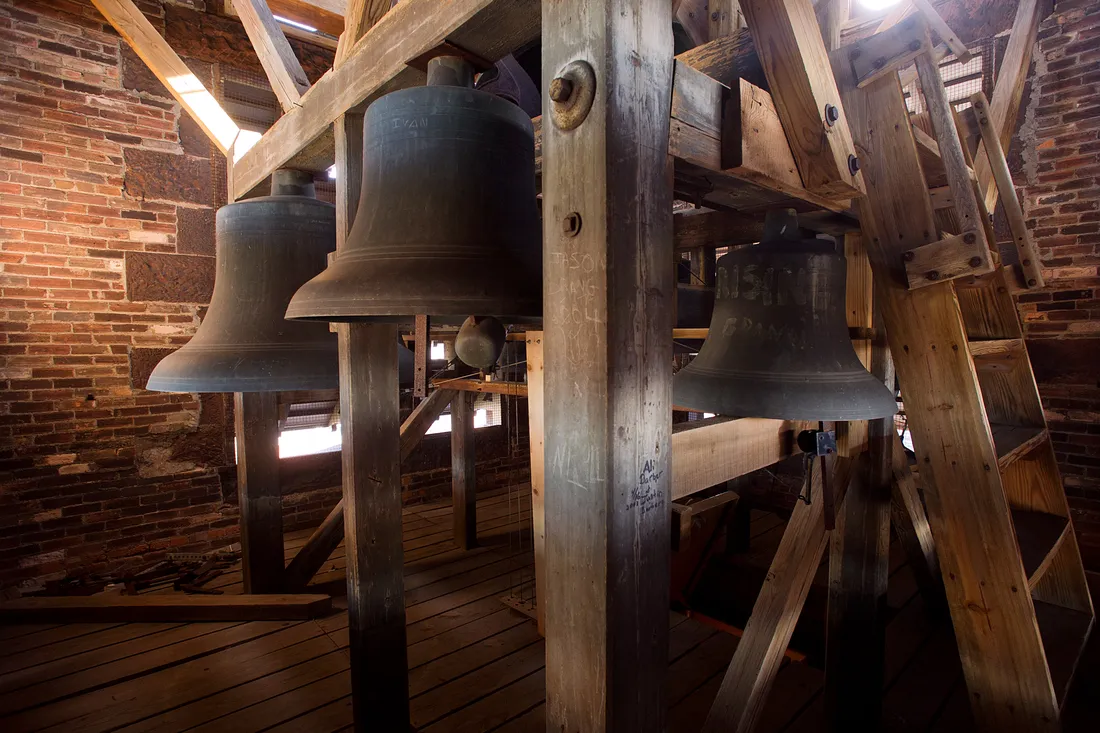
The Crouse Chimes consist of 14 bronze-cast bells operated by a system of levers and pulleys.
The Crouse Chimes make for good theater. Accessible by an unmarked door at the base of Crouse Tower, the bells are housed in a cylindrical, graffiti-laced room. (TV legend Dick Clark ’51 was among the Delta Kappa Epsilon brothers who supposedly scrawled his name on the brick turret wall.) A handwritten list of rules guards the Rube Goldberg-style chime station, mounted atop a 30-foot-high platform. “This is a secret organization. Do not spread your name,” warns Rule No. 3.
Former president Ross Chua ’20, G’21 divulged his identity shortly after undergraduate commencement. A longtime Chimesmaster, he appreciates the creative and emotional aspects of bell playing. “It draws on my two passions: making music and building community,” says Chua, who recently earned a master’s degree in audio arts. Arranging bell music that is challenging but accessible, he adds, is a perk of the job.
Bell playing is a universal language—you don’t have to read music to appreciate it. I can’t think of a better way to bring students together.
Another perk is the unique work environment. Chua chuckles at the mention of artifacts strewn about the bell tower—a frayed Quasimodo doll, a stuffed bat and an ancient pair of marching shoes glued to the chime station ladder. “I’ve talked to Chimesmasters from 20-30 years ago,” he continues, “and even they don’t know how the shoes got there.”
Meanwhile, visitors to Crouse Tower are required to sign a guestbook. “Chancellor Syverud has been here,” says Downing smiling. Nonmembers, however, may not enter the chime station or the group’s cramped quarters in the spire. “One time, we let [renowned jazz bassist] Adam Neeley operate the console and then sign his name on the wall. But not even he could get near the bells themselves.”
Speaking a Universal Language
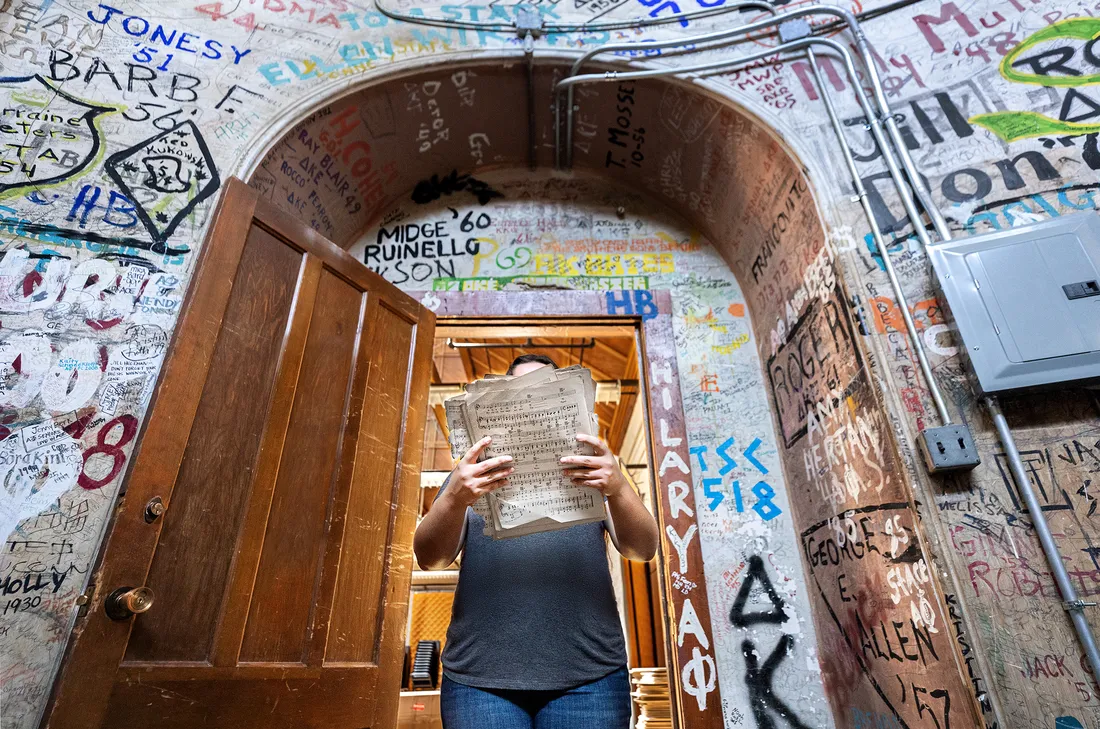
The belfry of Crouse College is littered with graffiti, some of which is more than a century old.
Although bell ringing is centuries old, modern-day groups like Chimesmasters are few and far between. Syracuse’s membership hovers around a dozen, with most of the participants being undergraduate music majors. “We used to recruit from the Setnor School of Music, but now we have an open application process,” says the group’s leader, known as “the Prez.” “Students from across the University may apply, but they don’t need to have bell playing experience.” Chua recalls a former member who was afraid of getting the boot because she couldn’t read treble clef music—the clef of choice for bell keepers. “She was a tuba player and played only bass clef,” he continues. “Eventually, she figured out how to transpose the notes and then became our president.”
With a sheet music collection just shy of a thousand, Chimesmasters draw from four stuffed binders. “Pop is our biggest one, by far, with more than 130 arrangements,” adds the Prez. The other binders are labeled “Classical/Folk,” “TV/Film/Disney,” and “Special/Holiday.” A classically trained musician, she appreciates the pop sensibilities of bell playing. Her favorites include arrangements of Meghan Trainor’s “All About That Bass,” John Legend’s, “All of Me” and Katy Perry’s “Firework.”
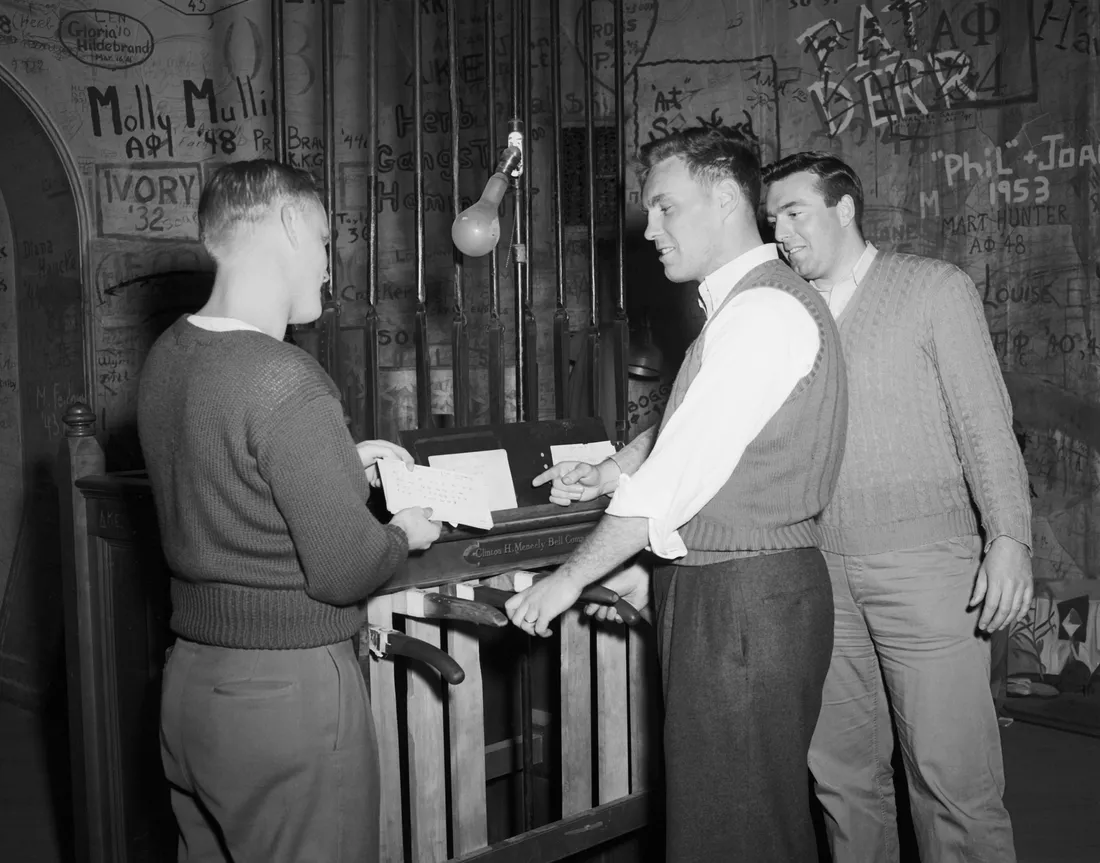
Members of Delta Kappa Epsilon played the bells for nearly a century, before ceding control to Chimesmasters in the late 1980s. (Syracuse University Archives, Special Collections Research Center)
“Each member arranges two pieces a month,” notes the group’s anonymous publicist, who goes by “Ms. PR.” “We gauge the popularity of our pieces by the responses they get on Twitter.” For instance, performances of “Avatar’s Love” from the animated TV series Avatar: The Last Airbender have prompted a flurry of tweets, like “You can’t play this while I’m at work. I’m going to cry.” By contrast, the K-pop earworm “Baby Shark” often triggers messages beginning with something like “please stop.”
A seasoned bell keeper, Ms. PR says the Crouse Chimes should not be confused with carillons, which consist of 23 or more harmonically tuned bells. While chimes are common tower instruments, the extent to which they are designed determines the complexity of their music. “Most of our pieces are fairly simple,” she says. “I’d love to see us add more bells so that we can mix it up a bit, inject more chromaticism.”
Each bell has its own tone, its own personality. Collectively, the chime creates something bigger than all of us.
Ms. PR’s go-to is the ABBA classic “Mamma Mia.” “I never get tired of playing it, and everyone enjoys hearing it.” Rounding out her hit parade are Pharrell Williams’ “Happy,” selections from Star Wars and Beauty and the Beast, and anything by the Beatles. “I really love “Ob-La-Di, Ob-La-Da,” but it’s tricky to play fast,” she adds.
The group presents solemn music, too. When gameshow host Alex Trebek died last fall, Chimesmasters responded with a moving version of the Jeopardy! theme. Downing, in turn, performs “Amazing Grace” at the annual memorial service for victims of the 1988 bombing of Pan Am Flight 103. “I had a student on that flight,” he says with a trace of emotion. “I often wonder what she’d be doing today if she were alive—maybe raising a family or performing on Broadway. Every year, it gets harder and harder for me.”
Adds the Prez: “Bell playing is a universal language—you don’t have to read music to appreciate it. I can’t think of a better way to bring students together.”

